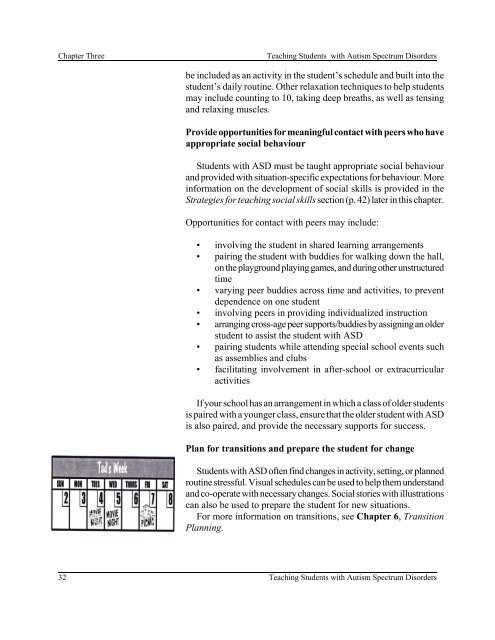Teaching Students with Autism Spectrum Disorders
Teaching Students with Autism Spectrum Disorders
Teaching Students with Autism Spectrum Disorders
Create successful ePaper yourself
Turn your PDF publications into a flip-book with our unique Google optimized e-Paper software.
Chapter Three <strong>Teaching</strong> <strong>Students</strong> <strong>with</strong> <strong>Autism</strong> <strong>Spectrum</strong> <strong>Disorders</strong><br />
be included as an activity in the student’s schedule and built into the<br />
student’s daily routine. Other relaxation techniques to help students<br />
may include counting to 10, taking deep breaths, as well as tensing<br />
and relaxing muscles.<br />
Provide opportunities for meaningful contact <strong>with</strong> peers who have<br />
appropriate social behaviour<br />
<strong>Students</strong> <strong>with</strong> ASD must be taught appropriate social behaviour<br />
and provided <strong>with</strong> situation-specific expectations for behaviour. More<br />
information on the development of social skills is provided in the<br />
Strategies for teaching social skills section (p. 42) later in this chapter.<br />
Opportunities for contact <strong>with</strong> peers may include:<br />
• involving the student in shared learning arrangements<br />
• pairing the student <strong>with</strong> buddies for walking down the hall,<br />
on the playground playing games, and during other unstructured<br />
time<br />
• varying peer buddies across time and activities, to prevent<br />
dependence on one student<br />
• involving peers in providing individualized instruction<br />
• arranging cross-age peer supports/buddies by assigning an older<br />
student to assist the student <strong>with</strong> ASD<br />
• pairing students while attending special school events such<br />
as assemblies and clubs<br />
• facilitating involvement in after-school or extracurricular<br />
activities<br />
If your school has an arrangement in which a class of older students<br />
is paired <strong>with</strong> a younger class, ensure that the older student <strong>with</strong> ASD<br />
is also paired, and provide the necessary supports for success.<br />
Plan for transitions and prepare the student for change<br />
<strong>Students</strong> <strong>with</strong> ASD often find changes in activity, setting, or planned<br />
routine stressful. Visual schedules can be used to help them understand<br />
and co-operate <strong>with</strong> necessary changes. Social stories <strong>with</strong> illustrations<br />
can also be used to prepare the student for new situations.<br />
For more information on transitions, see Chapter 6, Transition<br />
Planning.<br />
32 <strong>Teaching</strong> <strong>Students</strong> <strong>with</strong> <strong>Autism</strong> <strong>Spectrum</strong> <strong>Disorders</strong>

















